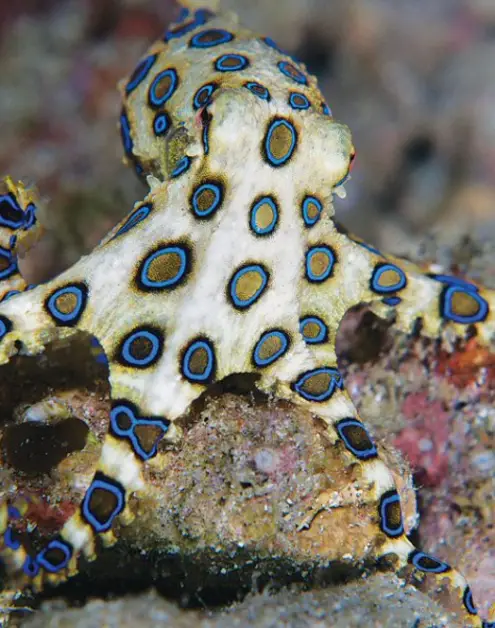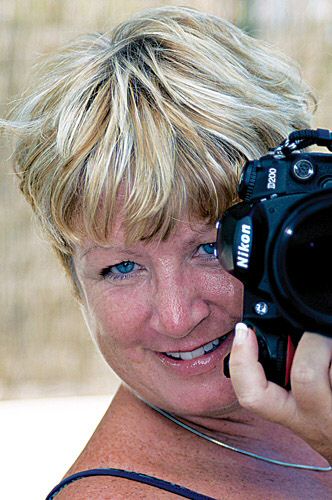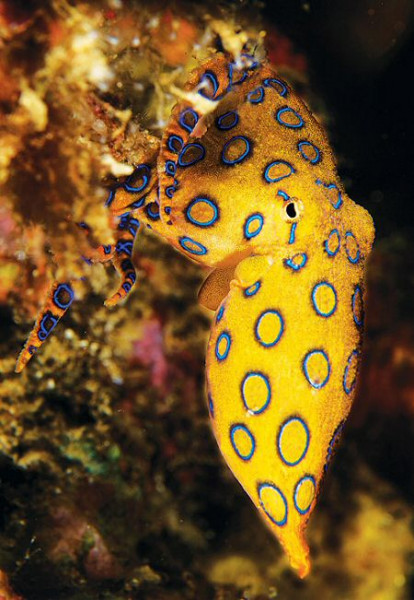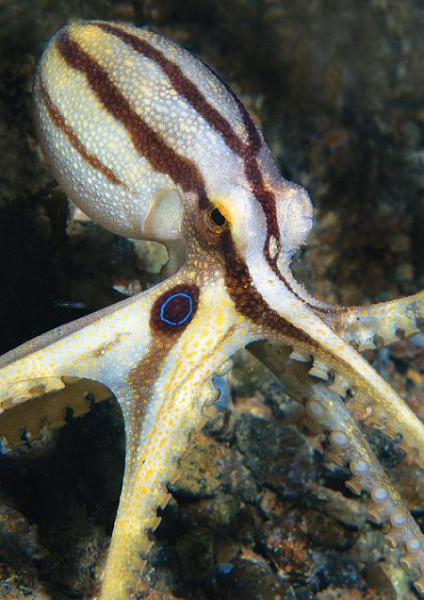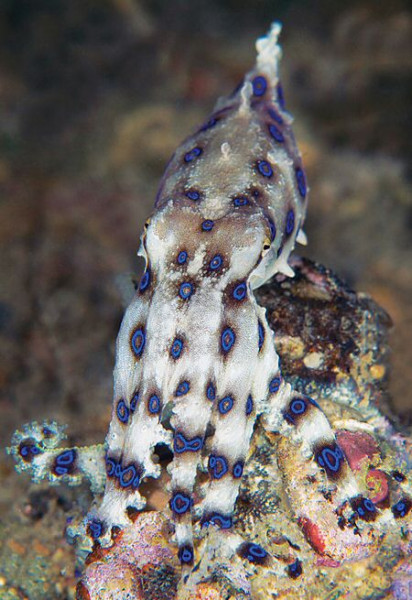The name blue-ringed octopus sends a shiver of terror through some – but for underwater photographers this tiny creature is an object of desire, say David & Debi Henshaw
OCTOPUSES LIVE THROUGHOUT THE OCEANS of the world, inhabiting the reefs ranging from a few metres to around 7000.
There are more than 200 reported species, but many more are being investigated and added to the list as time goes by.
Among these many species, one group in particular has captured the imagination of divers and photographers as a special occupant of the reef – the blue-ringed octopus.
These octopuses belong to the Ocellate group, the word translating as “with little eyes.
Color pattern changes triggered by the animal's behavior cause its false eyes to be displayed at the top of the two leading arms.
There are up to 10 recorded different species belonging to this benthic family, benthic meaning that they live most of their life on the reef floor among the coral and rocks that afford them protection and camouflage.
Blue-ringed octopuses, commonly referred to as BRO, are recorded not by size but by the number and size of blue spots they display.
Most common are the greater (Hapalochlaena lunulata) and lesser blue-ringed octopus (Hapalochlaena maculosa). The rarer poison ocellate octopus (Octopus mototi) displays only two single blue spots when agitated.
AS WITH ALL BENTHIC OCTOPUSES, the BRO have eight arms and are masters of camouflage.
It isn't easy to spot some of them on the open reef, as they probably won't measure more than 5cm, or 7cm with their arms extended.
That's the size of a tennis ball. In its natural state, the BRO has relatively dull brown/yellow markings with very faint outlines of blue rings.
It's not until it is aware of an intruder within its comfort zone that it responds with the color changes.
It displays the vibrant, iridescent blue rings, which can number from two to 50 depending on the species, as a danger sign to predators.
The BRO feeds on small crustaceans, killing its prey either through bite or poison – the definitive method has yet to be established.
It carries two toxins that can be delivered through its salivary glands to paralyze the nervous system of its prey. One is used to bring down the prey and the other, the more poisonous, is used in self-defence.
This neurotoxin, known as Tetrodotoxin, will paralyze a human within seconds, causing unconsciousness. There is no known antidote, and only by applying continuous CPR for 24 hours would the victim have any chance of survival.
This, as far as we know, is the deadliest toxin that attacks the neuro-system.
Having said this, very few people have lost their lives, but it is wise to keep a BRO at a safe distance should you decide to approach one.
Most attacks, as so often with wild animals, are caused by something or someone encroaching on the creature's comfort zone.
Other incidents are usually the result of accidents, where a diver or other sea-user has put a foot or hand in the wrong place unknowingly.
We can relate one incident in Mabul, Malaysia, where we were photographing a frogfish on a coral block just above the sandy reef bottom. You know when something just catches the corner of your eye?
Sure enough, only 30cm away were the flashing blue rings of a BRO, spotted just in time to avoid it!
It's not all good news for the BROs.
They live for around two years, and during this time reproducing females lay up to 100 eggs, which they guard and protect until they hatch up to eight weeks later.
The task completed, the female dies through lack of food and energy. It's even worse news for the males – they die straight after mating!
The hatchlings are fully developed at birth, and can feed and protect themselves through their camouflaging color cells from the moment they fall to the reef bottom to find refuge in the sand and rock crevices.
Octopuses such as BROs that produce a small number of eggs normally take up residence in the area in which they hatch, as opposed to high-producing egg-laying varieties such as the common octopus, which disperses over wider areas with the currents.
This is why many BROs are found in localized areas throughout different regions.
THESE SPECIAL CREATURES will always fascinate photographers. In these days of specialized lenses, the need to be close is not so vital, so be aware and show respect to these small creatures the next time you see one.
If your approach is calm and unthreatening, they will reward you with very special images.
Ideal hotspots to find a BRO? Well, they were originally found in Australia, but now are seen regularly in PNG, the Philippines, Indonesia, Malaysia and Japan.
If you are due to travel to any of the following areas you may well find them if you look hard enough, as we did – Lembeh Straits, Mabul, Sulawesi and Anilao. Good luck.
